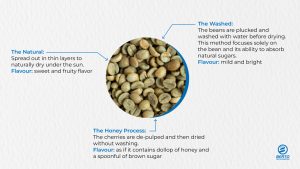Coffee Processing Methods: Natural, Washed, Honey
What does processing coffee entail? How does this process make your final brewed coffee taste the way it does?
While tea comes from its leaves, coffee is a fruit before anything else. The beans you buy are roasted seeds of coffee cherries.
A series of steps go into sourcing and separating that seed from the fruit. The process starts the second the cherry gets removed, as it directly affects how your coffee will taste. This is why every step of coffee processing is crucial! Any roaster will say the same.
There are different coffee processing methods, with each one lending itself to a different final cup flavor. Roasters will then select and blend differently processed beans to achieve their desired flavor profile.
Today, we talk about how to make coffee and what its process does to make the taste of your daily cup better.
What is coffee processing?
Coffee cherries are made up of several layers. It has a seed, pulp, mucilage around the seed, and a protective outer skin. Coffee processing refers to the removal of the layers that surround the seed. Essentially, the process begins as soon as the cherries are picked.
There are three basic methods to process coffee: Natural (also called the dry process), Washed (also called the wet processed) and Honey (also called pulped natural). Each method alters the sweetness, body, and acidity of brewed coffee differently.
The Natural Processing Method of Coffee
The most traditional, perhaps ancient, method that stems from Ethiopia is the natural coffee method, also known as the dry process. The cherries are harvested when they reach peak ripeness. Afterwards, they are spread out in thin layers to naturally dry under the sun. With this method, the fruit remains intact on the bean and dries undisturbed.
The cherries are then tossed and turned regularly to avoid fermentation, rotting, or moulding. Once fully dried, the green coffee bean is extracted from the skin and flesh, and then stored to ‘rest’ before roasting.
Many roasters have criticized the natural coffee processing method for its inconsistency in the final flavor. Inconsistency in flavor can occur due to the possibility of unripe cherries accidentally getting thrown into the mix and dried alongside ripe ones. However, this natural method has the potential to create some of the most flavorful coffee when consistency is achieved.
With this method, the bean is dried within the fruit, giving a sweet and fruity flavor to the bean. This is why natural coffee is known for its sweetness, which can be spectacular on its own or in a blend as it wonderfully adds a layer of depth to the final cup.
The Washed Method
Washed coffee is all about what’s on the inside, as this method focuses solely on the bean. While natural or honey-processed coffee relies on flavorful cherries, the washed method depends almost fully on the bean’s ability to absorb enough natural sugars and nutrients during its growing cycle. The environment plays a key role in the process, such as soil, weather and so on. It also comes down to the bean’s varietal.
The washed process can highlight the true personality of a single-origin bean the best. Hence, specialty coffees are often processed using this method. The washed method, also called the wet method, can be quick and efficient, however, considered environmentally wasteful, as a massive amount of water goes into the process. But some opt for the washed method, especially those who prefer a brew that is mild and bright, as it results in a clean flavour profile in the coffee.
The Honey Process
The honey or pulped natural process is a hybrid that combines elements of the two aforementioned techniques to achieve new differentiations in flavor. This practice is not as common, however, it can produce a unique cup with flavors that are similar to natural and washed coffee.
When done right, honey-processed coffee can taste as though someone has literally added a dollop of honey and a spoonful of brown sugar to your cup.
The name is actually derived from how sticky the beans get during coffee processing. The honey process is a method in which the cherries are de-pulped and then dried without washing. Some of the fruit’s elements are still there but not as whole as in the natural process. The cherry isn’t fully removed, just enough to leave a golden, sticky mucilage reminiscent of honey.

Another method that is primarily used in Indonesia is the wet-hulled method. We’ll discuss that in another post, so stay tuned!
Follow us on Instagram or like us on Facebook for more coffee-roasting news and trends. If you’re kicking off your roasting business, check out the roasters we have available for you and see which one suits your business goals!



